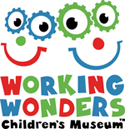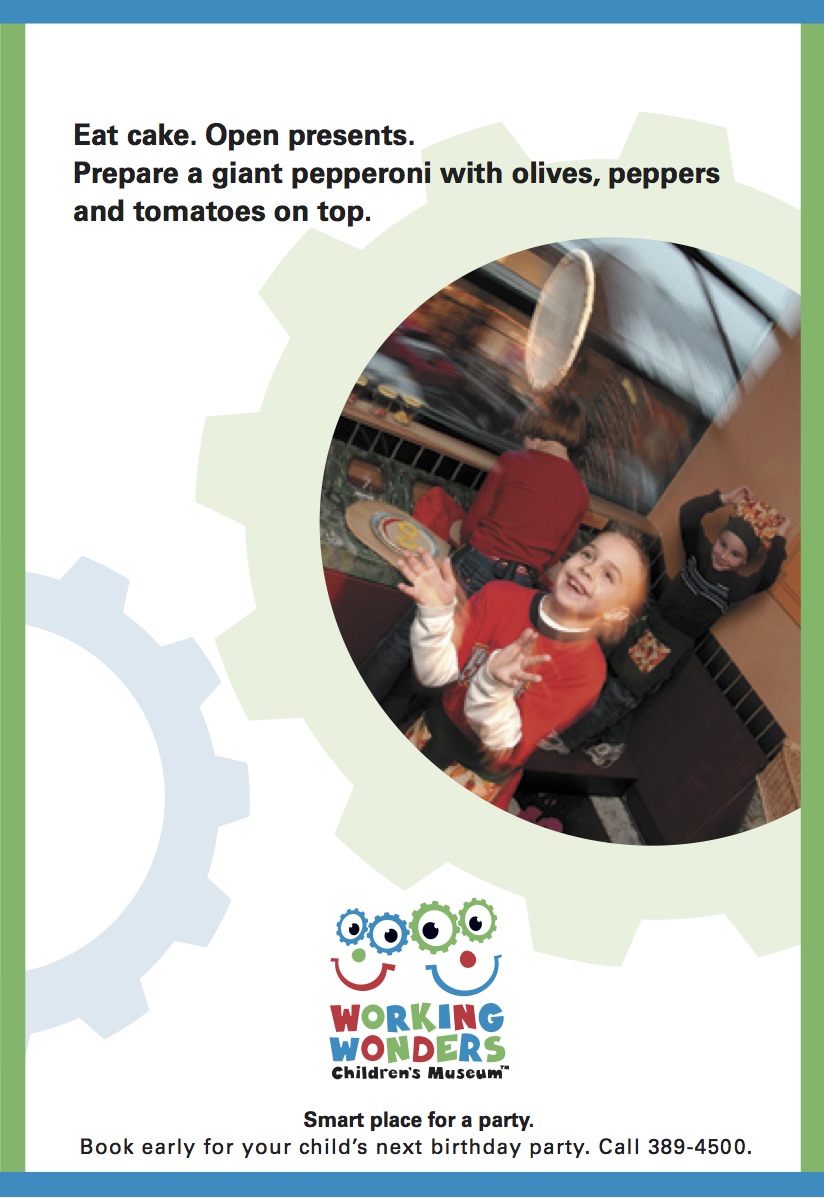![]() In the midst of the economic mayhem of 2009 I called it “A feel-good brand in a bummed out world.” It was the type of non-profit that genuinely touched people, and put big smiles on a lot of little faces. For me, a few minutes at Working Wonders Children’s Museum was a sure cure for a crummy day. It was also a great example of non-profit branding.
In the midst of the economic mayhem of 2009 I called it “A feel-good brand in a bummed out world.” It was the type of non-profit that genuinely touched people, and put big smiles on a lot of little faces. For me, a few minutes at Working Wonders Children’s Museum was a sure cure for a crummy day. It was also a great example of non-profit branding.

Our story of success, and failure, is valuable for anyone who’s starting a new business or running a non-profit organization. It was non-profit branding “by the book” all the way…
When we started Working Wonders we did a lot things right… First, we thoroughly researched the market and determined that there was a gaping need in Bend, Oregon for a year-round children’s attraction. (We conducted large-sample phone surveys as well as focus groups.)
Once we saw encouraging results from the research, we wrote a mission-focused brand strategy and built a business plan around that.
After our strategy was clear and the business plan was written, I came up with the brand name and my team designed a nice logo and put an operational plan in place based on our cohesive brand platform.

At first, Working Wonders was just a concept. A “museum without walls.”
Initially we raised just enough money to build some traveling exhibits and we went to every event in town to introduce kids, and their parents, to our brand of educational play.
And it caught on! Before the days of Twitter, it went viral.
Our bootstrapping, “museum without walls” strategy achieve the immediate goal: Proof of concept.
Parents and kids loved it. In less than three years we secured a location and we raised enough money to open the doors. Just barely. It was a crucial, “go or no-go” moment of decision.
The argument TO go: We figured it’d be easier to raise money once people could see a finished children’s museum. We knew we could spend years traveling around, trying to raise more money. (Many Children’s Museums spend a decade doing that.) Or we could get the doors open, and go from there.
The argument to NOT go: We’d be undercapitalized. Cash would be tight, and there was no endowment safety net. We were relying on the on-going generosity of a couple key donors and most of all, corporate sponsors.
We chose to go. Damn the torpedoes!
A team of volunteers scraped up donated materials, did the heavy lifting, and created a children’s museum that was small, but delightful. We launched in less than one-third the time and for one-fifth the cost of most children’s museums. It was a labor of love. A thing of beauty. A non-profit branding success and the biggest accomplishment of my marketing career.
Working Wonders ran successfully for four years. It broke my heart when it had to close because of the economic tidal wave that hit our town in 2009. Despite our best efforts and exceptional marketing, it was not sustainable.
Some people contend it was actually branded too well.
Many customers and community leaders thought we were part of a national chain of some sort. Never mind that our marketing was done with volunteer labor. (mine) Never mind that our advertising was mostly donated space. The general public simply couldn’t conceive of a little, local non-profit doing things so professionally. They figured we had all the money we needed, from some, mysterious, out-of -town source.
But there was no endowment. By the time we identified the perception problem and started addressing it with overt messaging, it was too late.
Our lessons learned from Working Wonders tie-in directly to an online discussion that I’ve been following about non-profit branding for marketing for 501c3 organizations. It’s an informative conversation between branding professionals that everyone can learn from. Profit or not.
One key question that came up:
What happens when the public image of a non-profit organization suffers because of commercial branding strategies?
One could argue that’s what happened with Working Wonders. However, there’s more to the story than that.
If not for commercial branding practices the children’s museum never would have opened in the first place. That’s how we were able to touch so many kids.
In hindsight, the execution of our marketing was not the issue. We did a great job of reaching the parents of young kids. They came in — over and over again.

Unfortunately, in the non-profit world customer satisfaction and brand loyalty doesn’t always translate to financial viability.
For children’s museums loyal, repeat customers aren’t enough. They also need loyal, repeat donors who can provide a hefty endowment.
That’s what we missed… the big dollar benefactors.
In a town of only 100,000 people those are hard to find, so we relied heavily on corporate sponsorships. Unfortunately, those dried up overnight when the economy tanked.
Nonprofits are often torn between two marketing objectives: Attracting visitors and attracting donors.
We woulda, coulda, shoulda spent less time getting kids in the door, and more time on a grass roots effort to raise money and load the board of directors with wealthy supporters.
So if you’re working with a small, local-level non-profit, by all means, do a professional job with your marketing. Non-profit branding is absolutely important!
But first and foremost, make sure you’re telling your story of need to the right people. Solidify the base of financial support first, in the form of wealthy, go-getter board members, then open your doors.
 It’s always a delicate balance to demonstrate that dire need without looking desperate. That’s your challenge as a non-profit marketer. And keep in mind, if the organization does not appear grass-rootsy, potential donors might jump to unfortunate conclusions about your funding sources.
It’s always a delicate balance to demonstrate that dire need without looking desperate. That’s your challenge as a non-profit marketer. And keep in mind, if the organization does not appear grass-rootsy, potential donors might jump to unfortunate conclusions about your funding sources.
If you’re in a for-profit venture, look closely at the passion and commitment of the people who help build non-profit organizations. At Working Wonders, we were all deeply passionate about the needs of our young kids. That cause is what fueled us.
What’s your “cause?” Every great brand has one, beyond just making money. Is it written down somewhere? Is your operational plan aligned with that? Does anyone really care? These are some of the key strategic questions you need to ask yourself, before you worry about executing your go-to-market plan.
And, of course, you have to balance that thinking with the practical, numbers and sense question of, “where’s the money coming from?”
For more marketing tips and non-profit branding advice, check out THIS post:
![]()

John,
Great story, great message.
Thank you,
Mark
John, Thanks for this wonderful recollection and lesson. I’m just now working on the 4th edition of Business Plans Kit For Dummies. I’m going to share this post with my co-author who is responsible for the chapter on business plans for non-profits. Your advice is real and rich. Thank you.